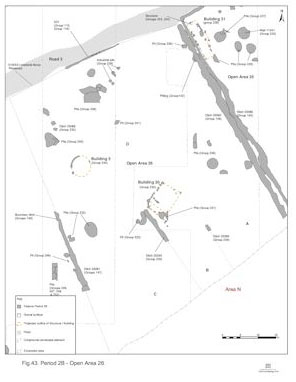
In comparison to Open Area 27, the range and complexity of inter-cutting features of Period 2B date is modest. However, there is sufficient evidence to hint at some ongoing development within this enclosure (Figure 43). The boundary is re-established or re-affirmed at the end of Period 2A.

Ditch 25092 (segs 11259, 11328, 11405, 11718, 11782, 23037, 23048, 23116, 23533) is a major NNW-SSE aligned boundary feature, traced for a distance of c. 60m, which is similar in size and parallel to ditch 25089 (Group 145) - less than 1.00m west of it. The north terminal coincides with the edge of Road/track 3 and is postulated to extend south as far as the terrace edge. The new ditch, therefore, duplicates the boundary between OAs 25 and 26. Traces of a possible re-cut are evident within a segment located toward the centre of its recorded north-south extent.
While some of the ditch fills include micaceous terra nigra and North Gaulish white ware, which could suggest that parts of the ditch were infilled during the first half of the 1st century AD, the pottery from the fills of ditch segment 23037 dates to the second half of the 1st century AD. This later date fits better with the fact that it cuts pit 11723.
It is unclear why this boundary should be supplemented or reinforced in this manner. The situation would be easier to understand if ditch 25089 were the later, in which case the formation of Open Area 25 could be seen as the creation of an additional enclosure to the east. However, the stratigraphic and dating evidence suggest that 25092 represents the later modification.
Pits 23361 and 23365 (Group 231) lie within the postulated footprint of Building 30. The earlier pit (23365) dates to the mid-1st century AD. It might be considered unlikely that the building would have been built over so recent a large pit and that therefore the pits post-date the building, but stratigraphic evidence is lacking.
Somewhat set apart in the north-west corner of Open Area 26, is pit 15641 (Group 240), which may have been cut as early as the early to mid-1st century AD and could be contemporary or perhaps even associated with adjacent ditch 25088. However, it continues to receive fills into the later part of the century. Indeed, its final fills may perhaps be regarded as falling just into Period 3 rather than Period 2B. The pit is distinctly triangular, almost bell-shaped in plan, with maximum dimensions of 3.86m by 3.86m, and 1m deep. The progression of dates up through the sequence of its fills (and its Period 3 re-cut 15993, Group 691, which maintains the exact shape of the original) suggest it remains open and is filled progressively for a period of time; although there may not be a very significant timespan involved.
The base of the pit appears to be lined with gravel and pebbles set in clay. The lower fills (those of the early to mid-1st century) are covered by a layer of grey-white ash (15611, not seen on section) and a layer of dark grey ashy silt (15602), before 15555 fills the remainder of the pit (mid-late 1st century). The ashy layers contain notable iron content, including at least two iron sheet fragments (SFs 8312, 6656), chisel (SF6119) and a nondescript lump (SF6659). At least some of the pottery in these fills is burnt. Two post-holes cut this sequence of fills. A further post-hole (15517), which is cut by this pit, may well also have been associated - as a marker of its intended location, for example. Recorded slot 15685 appears in fact to be a feature of the south side of the pit.
Although the finds assemblage from 15641 is less significant, the fill sequence is perhaps analogous to that of earlier pyre-debris pit 15417, but taking place perhaps over a longer timespan. Interpretation of this pit remains undetermined. A tentative suggestion that the post-holes within the cut denote the presence of sort of mortuary chamber structure cannot be sustained from the internal evidence of this feature alone; however, it must be borne in mind that only a slot through this pit was excavated.
Internet Archaeology is an open access journal based in the Department of Archaeology, University of York. Except where otherwise noted, content from this work may be used under the terms of the Creative Commons Attribution 3.0 (CC BY) Unported licence, which permits unrestricted use, distribution, and reproduction in any medium, provided that attribution to the author(s), the title of the work, the Internet Archaeology journal and the relevant URL/DOI are given.
Terms and Conditions | Legal Statements | Privacy Policy | Cookies Policy | Citing Internet Archaeology
Internet Archaeology content is preserved for the long term with the Archaeology Data Service. Help sustain and support open access publication by donating to our Open Access Archaeology Fund.